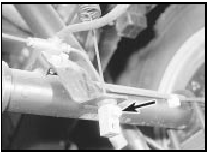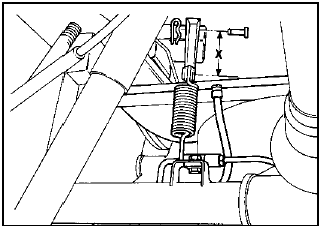Load apportioning valve (P100 models) - adjustment
Models before mid-April 1989 1 The vehicle must be unladen, at normal kerb weight (a full tank of petrol, but no driver or load).
2 With the vehicle standing on its roadwheels, remove the spring clip and clevis pin, and detach the spring from the valve operating lever.
3 Loosen the locknut on the abutment block at the bottom of the spring (see illustration).

25.3 Loosen the locknut (arrowed) on the abutment block
4 Slide the spring through the grommet in the bracket on the axle, until the correct “X” dimension is obtained between the centre of the spring eye and the centre of the valve operating lever eye (see illustration).

25.4 Load apportioning valve adjustment
X = 77.0 mm (3.0 in) with vehicle unladen at normal kerb weight
5 Hold the spring in position, slide the abutment block against the underside of the grommet, and tighten the locknut.
6 Attach the free end of the spring to the valve operating lever, and refit the clevis pin and spring clip.
Models from mid-April 1989 7 The procedure is as described above, but note that the dimension “X” has been revised to 92.0 mm (3.6 in) with the vehicle unladen at normal kerb weight.
See also:
Engine/manual gearbox assembly - reconnection and refitting
1 Reverse the procedure described in Section
11, noting the following points.
2 Before attempting to reconnect the engine
to the gearbox, check that the clutch friction
disc is centralised. This i ...
Accelerator pedal - removal and refitting
Removal
1 The pedal can be removed once the throttle
cable has been disconnected from it as
described in Section 7.
2 Undo the two pedal support bracket
retaining bolts and remove the pedal.
Ref ...
Engine - refitting (automatic transmission in vehicle)
1 Reverse the procedure in paragraphs 1 to
10 of Section 6, noting the following points.
2 Check that the engine adapter plate is
correctly positioned on its locating dowels. If
necessary, a cable ...
